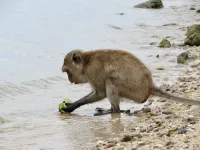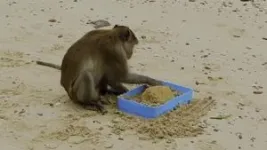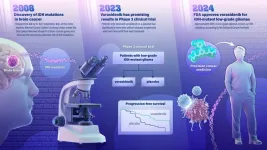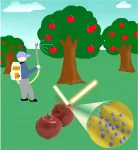(Press-News.org) Anyone who has picnicked on the beach has experienced the unpleasant crunch of a sandwich with a surprise helping of sand. But for primates, the tolerance for sand may depend on whether their energy is better spent reproducing and fighting rivals or on protecting their teeth from a mouthful of grit, according to a new Dartmouth study.
Social rank may determine whether animals prioritize immediate energy consumption over long-term health, or vice versa, the researchers report in the journal eLife. They observed the eating habits of long-tailed macaques on Thailand's Koram Island and found that the dominant and lowest-ranked animals briefly rubbed sand-covered food on their fur or between their paws before devouring it, along with most of the sand, and moving on to the next morsel.
Middle-ranked monkeys, however, having more time on their paws, carried their food to the water's edge and washed it in the sea to remove the sand. These animals often expended time and energy scrubbing their snacks past the point when they were clean and would even amble down the beach on their hind legs with their front paws full of food.
Nathaniel Dominy, the study's corresponding author and the Charles Hansen Professor of Anthropology at Dartmouth, says the findings provide insight into how animals—even those in hierarchical groups—choose survival strategies based on individual needs. The study supports the disposable soma hypothesis, which proposes that animals sometimes prioritize immediate survival and reproduction over longevity, Dominy says, adding, "Delayed gratification has its limits."
That may be the case for monkeys at the top and the bottom of the social ladder, for whom life is short and hard, Dominy says. As a result, these animals consume and conserve energy whenever they can. Existing research shows that sand causes significant damage to macaque tooth enamel. But for dominant males especially, that may not be important in a life fraught with challengers.
"High-ranking males are constantly lunging at or chasing other males, behaviors that maximize their siring of offspring. So, they need to eat rapidly to make up for that energy expenditure and that's exactly what we saw them doing," Dominy says. "They just stuff food into their mouths—sand be damned—because they don't have time to walk to the water. It's the urgency of now that matters, not their teeth. To humans, it seems like a shrewd calculation."
The monkeys that wash their food might instead be playing a long game, says Amanda Tan, the study's co-corresponding author and an assistant professor of anthropology at Durham University. Tan worked on the project as a postdoctoral scholar in Dominy's research group at Dartmouth.
"We think these animals invest a lot more time in washing their food because they cannot afford to damage their teeth and compromise their longevity," Tan says. "This strategy could allow them to maximize their potential reproductive success by living longer and producing more offspring over their lifetime."
The findings also could shed light on how the wear and pitting observed in the fossilized teeth of early humans relate to social structure and access to water, Dominy says.
"What if tooth wear is telling us about rank, not food properties," Dominy asks. "If we find more variable wear on a male hominin tooth, the classic interpretation is that it's the result of a varied diet. We ought to consider the possibility that he was eating quickly and couldn't be bothered to clean his food. Or maybe he lived in an area that was historically arid. We have cause to be more open-minded about variable tooth wear."
To observe the macaques' eating habits, Tan and the study's first author, Jessica Rosien '21, arranged plastic trays on the beach that contained cucumber slices. The slices were either on their own, placed on top of sand, or buried in sand. Rosien and Tan recorded the animals every day for six weeks as they foraged for cucumbers in the trays, capturing nearly 1,300 instances of food-handling by 42 individual macaques.
The monkeys that washed their food devoted an average of five seconds to over a minute to each cucumber slice—often washing multiple slices—while the average amount of time spent just brushing sand off a slice was effectively zero, the researchers report. That time makes a difference. In lab trials with sand-coated cucumbers, the researchers found that washing removed 93% of sand and brushing removed only 75%.
The researchers determined social rank using established methods of observing how the animals interact. But the social order was not subtle, Rosien says. She recalls a low-ranking male that, rejected by his peers, spent his time sitting next to her on the beach. A high-ranked female would fearlessly challenge other macaques for their cucumbers and steal anything Rosien left unattended, including her backpack of supplies. "I loved getting to know the different monkeys' personalities over time and I definitely got a sense of the impact of social rank," she says.
Before the study, Tan worked on Koram Island for years observing how the macaques developed skills using tools through social learning. She knew that some animals washed their food while others did not. It was Dominy who wondered if there was a rank-based trade-off between getting calories quickly versus preventing tooth wear, Tan says. "To our knowledge, no one had tested the hypothesis that food-washing served as an adaptive function for removing grit," she says.
Food-washing among primates is not common, Dominy says. The Koram Island macaques were first observed doing so after the 2004 Indian Ocean earthquake and tsunami. Their habit became a draw for tourists, who, before authorities put a stop to it, would throw fruit on the beach from boats to watch the animals wash it in the surf.
The other known instance is among the Japanese macaques on Japan's Kōjima Island. In the 1950s, researchers studying the animals lured them toward the beach with wheat and sweet potatoes to observe them more clearly.
In 1953, a young female named Imo first picked up a sandy sweet potato and washed it in a stream. Five years later, the other animals had taken up the practice, washing their food in the sea. Today, 92% of the Kōjima Island macaques wash their food.
"I love the story of Imo," Rosien says. "It shows how an individual can cause a shift in a whole population. To see such a significant advance in real time makes it easier to understand how small changes can lead to big changes."
The spread of a similar habit in two independent populations separated by 50 years and 5,000 miles speaks to the value of culture, Dominy says.
"You have to be experimental and entrepreneurial to invent a new behavior out of whole cloth, but it has to be clear enough that other individuals will understand its purpose and copy it," he says. "And they have to be smart enough to recognize when another animal has figured out something valuable. That's what culture is—seeing the value of a new behavior and adopting it."
The value for the macaques of washing their food was considered so obvious, no one had studied it before, the researchers write in their paper. "Even if something seems intuitive, it’s still important to be curious, ask questions, and test assumptions," Tan says.
"In this case," she continues, "our study provides a fuller picture of the various trade-offs that animals may juggle relative to their place in a social structure and gives us a better understanding of how that leads individuals to behave distinctly."
###
END
Social rank may determine if animals live fast, die young
Dartmouth study of macaques suggests leaders put immediate survival above longevity.
2024-08-07
ELSE PRESS RELEASES FROM THIS DATE:
Cutting-edge 3D-printed microneedle technology revolutionizes remote healthcare
2024-08-07
Los Angeles, California – August 6, 2024 - In a significant leap forward for healthcare equity and accessibility, researchers at the University of Victoria and the Terasaki Institute for Biomedical Innovation (TIBI) have developed a revolutionary system that combines remote health monitoring and drug delivery using 3D-printed hollow microneedles. This innovative approach, detailed in a recent study published in Advanced Healthcare Materials, promises to transform healthcare delivery, particularly for those in underserved or remote regions.
The ...
Blood test can help predict chronic lung disease in preterm babies
2024-08-07
A blood test can help predict which preterm babies will go onto develop chronic lung disease, allowing for earlier diagnosis and more targeted treatments, according to a new study.
The research, led by Murdoch Children’s Research Institute (MCRI) and published in the American Journal of Respiratory Cell and Molecular Biology found that changes in certain blood proteins, alongside gestational age, birth weight and sex, strongly predicated bronchopulmonary dysplasia (BPD) within 72 hours of life.
BPD usually occurs when a baby’s lungs are damaged by respiratory support and the long-term ...
Demystifying APE1: New findings on direct activation of ATM signaling by DNA single-strand breaks
2024-08-07
New research from a team of genome scientists and DNA damage response experts breaks new ground in understanding the function of a protein currently limited in clinical trials for cancer treatments.
Led by Haichao Zhao, PhD, in the Yan Lab at UNC Charlotte, the new research shows how ATM-mediated signaling is induced by DNA single-strand breaks (SSBs) for DNA damage repair – illuminating the distinct mechanisms of SSB-induced ATM kinase and shedding an important light on APE1 function.
In the new study, published today in Nature Communications, ...
Study suggests an MRI may help doctors predict more aggressive prostate cancer in patients
2024-08-07
SOUTHFIELD, MI, Aug. 7, 2024 - New Corewell Health™ research suggests an MRI scan can help predict whether patients with intermediate-risk prostate cancer (cancer confined to the entire prostate) may have more aggressive cancer in five years. Knowing this could potentially help doctors determine if treatment is needed up front vs. using a method called active surveillance where the disease is closely monitored over time. The study, recently published in the Journal of Urology, is the first to evaluate this risk group.
Currently, there has been a growing trend to manage low-risk prostate cancer patients with active ...
FDA approves drug targeting Johns Hopkins-discovered brain cancer gene mutation
2024-08-07
FOR IMMEDIATE RELEASE
A new drug for treatment of a type of brain cancer, called IDH-mutant low-grade glioma, was approved Aug. 6 by the U.S. Food and Drug Administration (FDA). The promising new drug stems from a 2008 genetic discovery made at the Johns Hopkins Kimmel Cancer Center.
The drug, called vorasidenib, is a targeted cancer therapy that works by inhibiting the activity of a mutated gene called IDH, slowing the growth of the cancer. The gene was identified by Bert Vogelstein, M.D., and team at the Johns Hopkins Kimmel Cancer Center’s ...
LOINC® semiannual release: Global partners collaborate to enhance semantic interoperability with health terminology updates
2024-08-07
INDIANAPOLIS -- Regenstrief Institute’s latest LOINC® content update underscores significant strides in health terminology, accomplished through extensive collaboration with the international health community. The semiannual release aims to bolster the electronic exchange of clinical and laboratory data, fostering the use and implementation of LOINC standards across healthcare systems globally.
The Regenstrief Institute Health Data Standards (HDS) unit, which administers LOINC, and partners collaborated to create more than 3,000 updates, including ...
Researchers show pesticide contamination is more than apple skin deep
2024-08-07
Pesticides and herbicides are critical to ensuring food security worldwide, but these substances can present a safety risk to people who unwittingly ingest them. Protecting human health, therefore, demands sensitive analytical methods to identify even trace levels of potentially harmful substances. Now, researchers reporting in ACS’ Nano Letters have developed a high-tech imaging method to detect pesticide contamination at low levels, and its application on fruits reveals that current food safety practices ...
Current challenges evaluated for measuring and treating fatigue in multiple sclerosis
2024-08-07
East Hanover, NJ – August 7, 2024 – Kessler Foundation research scientist John DeLuca, PhD, has published a significant clinical article in Journal of Neurology, shedding light on the elusive nature of fatigue in multiple sclerosis (MS) and its implications for treatment. The study provides a comprehensive review of current challenges in defining, measuring, and treating MS-related fatigue, offering new insights and directions for future research.
The open access article, “Fatigue in multiple sclerosis: can we measure it and can we treat it?” (Doi: 10.1007/s00415-024-12524-9), was published on July ...
Disparities found in survival benefits for people receiving bystander CPR for cardiac arrest
2024-08-07
A National Institutes of Health (NIH)-supported study has found race- and sex-based differences in the increased chances of survival from people who received bystander cardiopulmonary resuscitation (CPR) for out-of-hospital cardiac arrest. Average survival benefits for cardiac arrest, when the heart suddenly stops beating, could be three times as high for white adults compared to Black adults and twice as high for men compared to women. The findings published in Circulation.
“CPR saves lives — that, we know,” said Paula Einhorn, M.D., a program officer at NIH’s National, Heart, Lung, and Blood Institute ...
Florey research finds association between prenatal exposure to plastics and autism in boys
2024-08-07
Florey researchers have found evidence of higher levels of the plastic chemical bisphenol A (BPA) in pregnant mothers who gave birth to sons with autism.
Research published in Nature Communications, led by Florey scientists Dr Wah Chin Boon and Professor Anne-Louise Ponsonby, supports the hypothesis of a possible link between autism and exposure to plastic chemicals in the womb.
Professor Ponsonby said the researchers analysed two large birth cohorts – the Barwon Infant Study (BIS) in Australia and the Columbia Centre for Children’s Health and Environment in the USA.
“Exposure to plastic chemicals ...
LAST 30 PRESS RELEASES:
New technique lights up where drugs go in the body, cell by cell
New study finds movement of fishing fleets can reveal shifts in marine ecosystems
Embargoed: New evidence points to potential treatment for vascular dementia
Study uncovers disrupted brain balance in alcohol dependence
Working in groups can help Republicans and Democrats agree on controversial content moderation online
Structural findings reveal how distinct GPCR ligands create different levels of activation
Anything-goes “anyons” may be at the root of surprising quantum experiments
UC review: Maximizing workplace opportunity for veterans
From generation to complex control: Metasurfaces make perfect vortex beams "within reach"
Thin-film lithium niobate-based detector: recent advances and perspectives
Exploring why some people may tend to persistently make bad choices
How cells balance their protein levels
Nirsevimab vs RSVpreF vaccine for RSV–related hospitalization in newborns
Effectiveness and impact of maternal RSV immunization and nirsevimab on medically attended RSV in US children
AI gives scientists a boost, but at the cost of too many mediocre papers
Next-generation vision model maps tree growth at sub-meter precision
Genes aren’t destiny for inherited blindness, study shows
MIT study: High-fat diets make liver cells more likely to become cancerous
Exposure to multiple fine particulate matter components and incident depression in the US Medicare population
Risk of burdensome health care spending over time in the US
Nirsevimab against hospitalizations and emergency department visits for lower respiratory tract infection in infants
New microfluidics technology enables highly uniform DNA condensate formation
A new strategy for immune tolerance
Super Mario Bros. help fight burnout: New study links classic games to boosted happiness
Deepest gas hydrate cold seep ever discovered in the arctic: International research team unveils Freya Hydrate Mounds at 3,640 m depth.
Integrating light and structure: Smarter mapping for fragile wetland ecosystems
ACA-SIM: A robust way to decode satellite signals over complex waters
Probiotics can restore gut microbiome in breastfed infants
AI could help predict nutrition risks in ICU patients, study finds
Federal EITC has unexpected result, researchers say – it decreases domestic violence
[Press-News.org] Social rank may determine if animals live fast, die youngDartmouth study of macaques suggests leaders put immediate survival above longevity.







